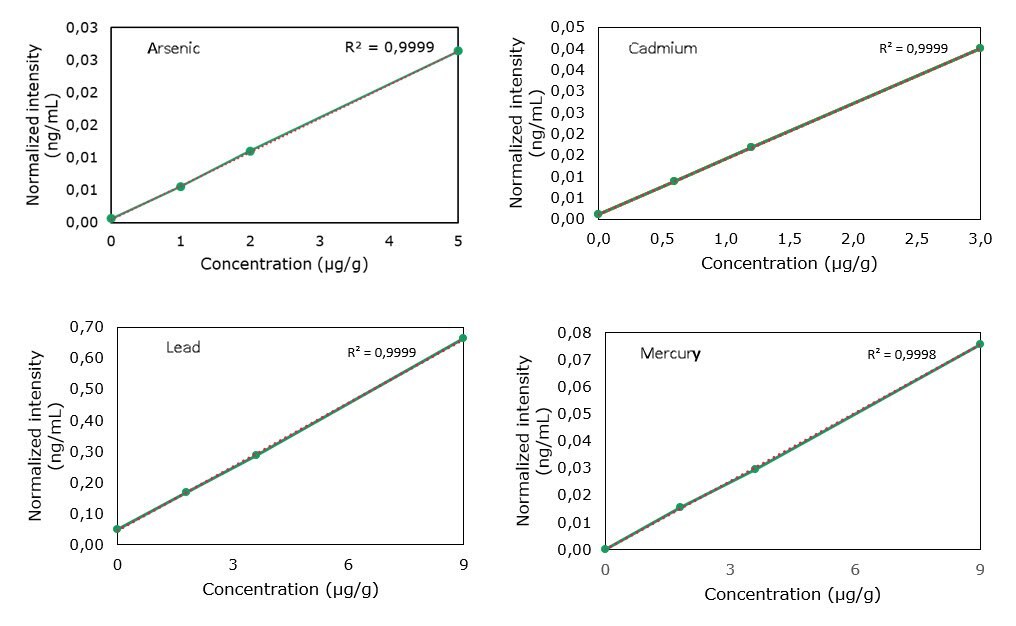ICP-MS Analysis of Heavy Metals in Cannabis Sativa
Introduction
Hemp (or: industrial hemp) and cannabis are strains of the Cannabis sativa plant differentiated on the basis of total delta-9-tetrahydrocannabinol (delta-9-THC) content (delta-9-THC and tetrahydrocannabinolic acid (THCA)). Cannabis sativa plant material that exceeds 0.3% wt/wt THC on a dry weight basis is considered to be marijuana (cannabis) under the US Controlled Substances Act. Industrial hemp is Cannabis sativa L. with a THC threshold below 0.3% (= % THCA x 0.877 + % Delta-9-THC). Definitions of hemp and cannabis are regulated in a specific manner in many parts of the world. In this work hemp material has been utilized, but all descriptions are valid for cannabis as well.
Hemp is known to accumulate heavy metals such as lead, cadmium, arsenic, mercury, chromium, nickel, manganese and cobalt in its roots, shoots, buds and seeds, and has been used for the remediation of contaminated soil (phytoremediation and phytoextraction).
On the other hand, this property may hinder the use of hemp in food or medical industries. As a consequence, all hemp material used in either food or pharma products must be tested for the heavy metal content.
As of February 2020, Canada and 24 US states have issued regulations for the testing of heavy metal content in cannabis, and all have provided limits for arsenic, cadmium, mercury and lead. In addition, four states have also set limits for one or more of these metals: chromium, barium, silver, selenium, antimony, copper, nickel and zinc.
This report describes the analysis of arsenic, cadmium, mercury and lead (elements typically referred to as the “big four”) by inductively coupled plasma coupled to mass spectrometry (ICP-MS) for three different Cannabis sativa varieties of industrial hemp (cannabidiol (CBD) and cannabigerol (CBG) content: information from manufacturer):
• Hemp buds “Felina”, CBD/CBG content 3.8/0.2%
• Hemp buds “Santhica”, CBD/CBG content 3.9/0.2%
• Hemp buds “Finola”, CBD/CBG content 3.8/0.2%
State Regulations
The tables below list the “big four” heavy metals and their limits based on jurisdiction and route of administration for various US states and Canada (all data as of February 2020).
Hemp Sample Preparation and Preparation of Internal Standard, Blank and Cannabis Sample Solutions |
|---|
Calibration: Preparation of Heavy Metal Standard Addition Solutions
In order to compensate for sample matrix effects, a standard addition approach utilizing various Certified Reference Material (CRM) Heavy metal mix standard solutions were applied for the preparation of all calibration curves. The final calibration curve was comprised of four data points (three standard addition solutions plus sample solution).
Preparation of Standard Addition Solutions (hemp “Felina”)
Preparation of Standard Addition Solutions Using Heavy Metal Mix III Standard Solution (As, Cd, Hg, Pb)
Preparation of Standard Addition Solutions using Heavy Metal Mix IV Standard Solution (As, Cd, Hg, Pb)
Preparation of Standard Addition Solutions (hemp “Santhica”)
Preparation of Standard Addition Solutions Using Heavy Metal Mix V Standard Solution (As, Cd, Hg, Pb)
Preparation of Standard Addition Solutions Using Heavy Metal Mix VI Standard Solution (As, Cd, Hg, Pb)
Preparation of Standard Addition Solutions (hemp “Finola”)
Preparation of Standard Addition Solutions Using Heavy Metal Mix VII Standard Solution (As, Cd, Hg, Pb)
Preparation of Standard Addition Solutions Using Heavy Metal Mix VIII Standard Solution (As, Cd, Hg, Pb)
Hemp sample digestion |
|---|
ICP-MS analysis of hemp |
|---|

Experimental results |
|---|
Conclusion
This work demonstrates a comprehensive ICP-MS workflow, using the standard addition calibration method, for determination of heavy metals in Cannabis sativa plant materials. Critical elements in the process include homogenization of samples and use of accurate traceable Certified Reference Material mixes that are tailored to state specific regulations for heavy metals in cannabis. Reproducible samples were prepared by grinding the hemp with a cryo ball mill. Samples were then digested utilizing a specific digestion protocol optimized to provide clear digestion solutions. The resulting solutions were subjected to ICP-MS analysis. Calibration data was obtained by the preparation and analysis of standard addition solutions obtained by diluting six different heavy metal CRM mixes containing arsenic, cadmium, lead and mercury. The final results were consistent and revealed a Cd and Hg concentration of <0.1 ppm for all hemp samples. The Finola variety contained 0.1 ppm arsenic and 0.4 to 0.7 ppm lead was detected in all three hemp varieties.
To continue reading please sign in or create an account.
Don't Have An Account?